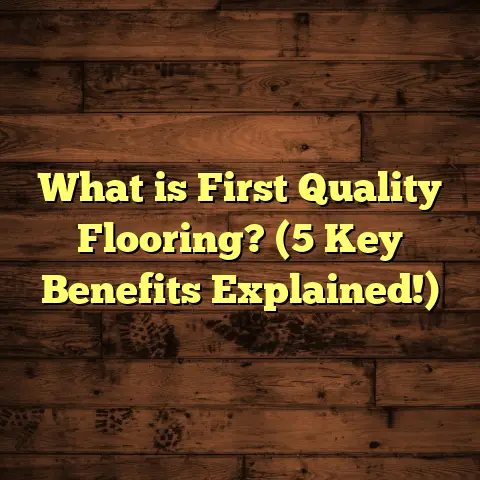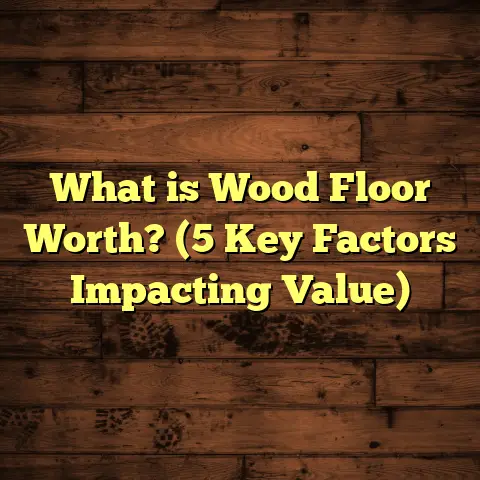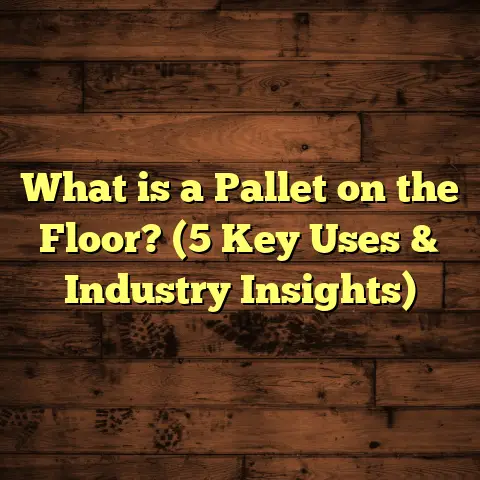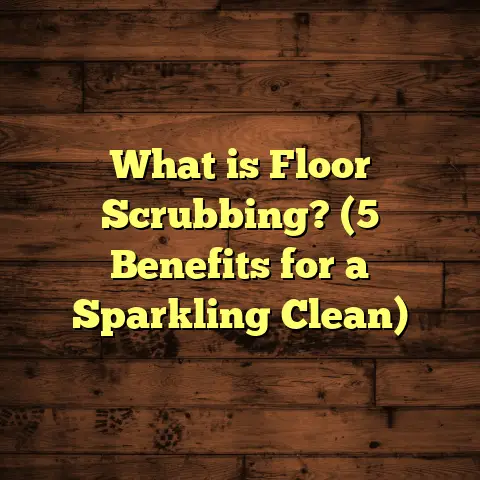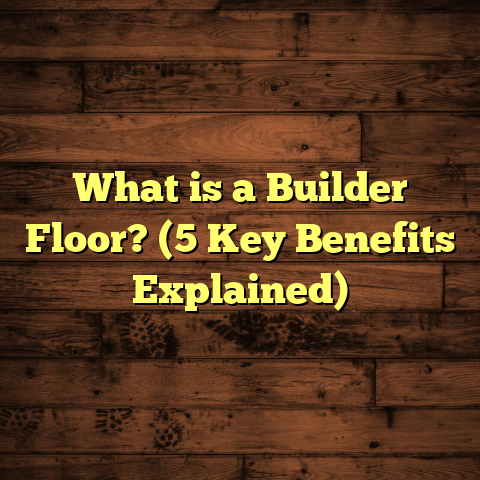What Is Epoxy Flake Flooring? (5 Benefits for Durability & Style)
A trendsetter’s choice often blends durability with a splash of style that sets a space apart from the ordinary. When I first discovered epoxy flake flooring, I was immediately drawn to how it transformed plain concrete into something vibrant, tough, and surprisingly elegant. If you’ve ever wondered how some garages, basements, or commercial spaces keep looking pristine despite heavy use, epoxy flake flooring might just be the secret behind that magic.
I’ve installed dozens of epoxy flake floors over the years, and each project tells a story about how this material can change a space — not just in looks but in functionality. Whether you’re considering a DIY project or hiring a professional, I want to walk you through everything I’ve learned so you can make choices that truly benefit your home or business.
What Is Epoxy Flake Flooring?
Epoxy flake flooring is a specialized coating system. It involves applying a base coat of epoxy resin onto concrete or other surfaces, then broadcasting colored vinyl flakes onto that wet layer. After the flakes settle and the base coat cures slightly, several clear epoxy topcoats seal everything in place. The result is a smooth yet textured floor with a speckled, decorative appearance.
This isn’t just about aesthetics. The flakes add traction and hide surface imperfections like small cracks or stains. The epoxy resin creates a hard, durable shell that stands up to heavy wear and tear far better than paint or simple sealers.
When I first encountered epoxy flake flooring on a commercial project, I was impressed by how it managed to be both decorative and extremely rugged. Later on, as I experimented with different flake sizes and colors for residential clients, I realized this system offers a wide range of design possibilities — from subtle elegance to bold statements.
How This Flooring Works
To understand why epoxy flake flooring performs so well, it helps to know a bit about its layers:
- Primer/Base Coat: A high-quality epoxy primer is applied first to ensure strong adhesion to the concrete.
- Flake Broadcast: While the base coat is still tacky, vinyl flakes are thrown or broadcast evenly across the surface.
- Scraping: After the flakes settle, excess flakes are scraped off to avoid thick spots.
- Topcoat Layers: One or more clear epoxy coats go over the flakes to lock them in place and provide a smooth finish.
The flakes themselves are usually made of vinyl or acrylic materials in various colors and sizes. They reflect light differently depending on their angle, creating depth and texture that’s hard to replicate with paint alone.
Why Choose Epoxy Flake Flooring? 5 Benefits for Durability & Style
I want to share the top reasons why epoxy flake flooring stands out as a smart choice for anyone looking beyond basic floors.
1. Durability That Lasts
Epoxy flake floors are built to take a beating. The epoxy resin forms a hard shell that resists scratches, stains, and chemicals — perfect for high-traffic areas or spaces exposed to spills and heavy equipment. In fact, data from industry reports show that epoxy coatings can last over 10 years with minimal maintenance when properly applied.
In my experience working with commercial clients, epoxy flake floors often outlast traditional tile or carpet by years. One gym owner told me that their floor still looks great after three years of nonstop dumbbell drops and treadmill traffic.
Durability doesn’t just mean resistance to physical damage. Epoxy flake floors also withstand moisture penetration better than many other options. This makes them ideal for basements or industrial settings where water exposure is common.
Personal Story: The Warehouse Transformation
I once worked on a warehouse floor that had serious wear and tear from forklifts and heavy pallets. The concrete was cracked, stained with oil and chemicals, and looked like it was ready for replacement. After prepping the surface extensively, we installed an epoxy flake floor with medium-sized black and gray flakes mixed for camouflage effect.
Six months in, the manager called me saying they were “blown away” by how much easier it was to keep clean and how no further cracks had appeared. The floor’s durability meant they avoided downtime for repairs — saving thousands in lost productivity.
2. Slip Resistance for Safety
The textured surface created by the vinyl flakes adds natural traction to the floor. This is especially important in garages, kitchens, or bathrooms where slips and falls are common concerns. Unlike smooth epoxy coatings, the flake pattern provides grip without needing extra anti-slip additives.
Safety is often underestimated when choosing flooring materials. But slip resistance can prevent costly injuries and insurance claims. According to the National Floor Safety Institute (NFSI), floors with adequate slip resistance reduce slip-and-fall accidents by over 50%.
A daycare center I worked with chose epoxy flake flooring precisely because staff reported fewer slip incidents after installation. The kids’ play area had a smooth base but enough texture from the flakes to prevent slips even when water was spilled.
Tips for Maximizing Slip Resistance
- Choose larger flakes for more texture.
- Ensure the topcoat has anti-slip properties if the floor will be wet frequently.
- Avoid overly glossy finishes in areas prone to moisture.
3. Style Variety to Match Your Space
You might think industrial floors have to be dull gray slabs. However, epoxy flake systems come in countless color combinations. From subtle earth tones to bold blues or reds, you can customize the flakes’ colors and sizes to create a unique floor design.
One client wanted a nautical theme for their beach house basement. We mixed blue, white, and sandy beige flakes to mimic ocean waves. The result? A floor that’s both functional and a conversation starter.
Another homeowner wanted a neutral palette for their modern kitchen but didn’t want boring white or gray floors. We settled on small black and white flakes dispersed evenly over a light gray base coat — giving subtle speckling that added interest without overwhelming the space.
How to Choose the Right Colors
Consider your lighting and room size. Lighter colors make spaces feel bigger and brighter but show dirt more easily. Dark colors hide stains but can make rooms feel smaller.
Also think about your furniture and wall colors so your floor complements rather than clashes with your décor.
4. Easy Maintenance Saves Time and Money
Cleaning an epoxy flake floor is straightforward — usually just sweeping and occasional mopping is enough. Because of its sealed surface, dirt doesn’t settle into cracks or grout lines like tile floors do.
For homeowners juggling busy schedules, this ease of maintenance is a huge plus. Commercial clients appreciate it too; janitorial costs drop significantly when they don’t have to deep-clean grout or replace worn carpets frequently.
One restaurant owner I worked with switched from traditional tile to an epoxy flake floor in their kitchen prep area. They reported cleaning time cut by half because grease stains wiped off easily without scrubbing grout lines.
Maintenance Tips
- Use pH-neutral cleaners to avoid damaging the epoxy.
- Avoid harsh chemicals like bleach or ammonia.
- Repair any chips promptly to maintain seamless protection.
5. Cost-Effective Over Time
While the upfront cost might seem higher than traditional paint or basic sealers, epoxy flake flooring offers excellent value long-term. Its durability means you avoid frequent repairs or replacements.
Speaking from personal experience, using tools like FloorTally has helped me get accurate cost estimates for projects involving epoxy flake floors. It factors in local labor rates, waste material needs (which are important with flake broadcast), and material costs. This way, I’m confident about budgets from start to finish — no surprises.
How FloorTally Helps Me
When planning larger jobs, I input dimensions, material choices, labor costs, and waste factors into FloorTally. It quickly provides an estimate reflecting the true cost including extra materials needed due to waste during broadcast application.
This upfront clarity helps me advise clients on cost-saving options without compromising quality — such as adjusting flake size or reducing layers if budget is tight.
Going Beyond Basics: Advanced Insights Into Epoxy Flake Flooring
Now that we’ve covered the essentials let me share some advanced tips and observations from my years installing these floors.
What Makes Epoxy Flake Flooring Different From Other Epoxy Floors?
Not all epoxy floors use flakes — some are smooth colored coatings or clear finishes over plain concrete. Epoxy flake systems add texture which improves aesthetics and performance.
Compared to solid-color epoxy floors:
- Flaked floors hide dirt better.
- They tolerate minor surface damage without showing it.
- They offer superior slip resistance naturally.
If you want something simple but functional without extra design flair, solid coatings work fine. But if you want style plus performance benefits, flakes are worth considering.
Environmental Impact & Sustainability
Epoxy resin is petroleum-based which raises environmental concerns for some homeowners. However:
- Epoxy floors last much longer than alternatives reducing waste.
- Some manufacturers now offer low-VOC formulations reducing harmful emissions during installation.
- Proper disposal of old flooring materials is important to avoid landfill build-up.
I always discuss environmental preferences with clients upfront so we can select products aligning with their values.
Installation Challenges & How I Overcome Them
Applying epoxy flake flooring isn’t foolproof — surface prep errors cause failures like peeling or bubbling.
I insist on:
- Grinding concrete thoroughly to remove old coatings.
- Moisture testing before installation because damp slabs ruin adhesion.
- Temperature control during application; epoxy cures poorly in cold or humid conditions.
- Careful timing of flake broadcast; too early or late affects embedment quality.
By following these steps strictly on every job site I reduce callbacks significantly compared to less experienced installers.
Case Studies From My Projects
Residential Garage Makeover
A client’s garage had cracked concrete stained by oil drips — classic scenario for epoxy flake flooring use.
We chose medium-sized gray and black flakes over a charcoal base coat. Prep took two days due to cracks needing filling and grinding.
After application:
- The surface looked flawless.
- Oil stains disappeared under opaque coating.
- Traction improved noticeably; client felt safer moving tools around.
- Cleanup became effortless; no more scrubbing stains out of concrete pores.
They told me it felt like their garage went from “dungeon” to “showroom.”
Commercial Kitchen Upgrade
A popular restaurant wanted better flooring in their prep area that could handle grease spills without frequent replacements.
We applied an epoxy flake system with blue-gray flakes over industrial-grade primer plus three clear topcoats for max chemical resistance.
Benefits reported after six months:
- Significant reduction in slip incidents.
- Faster cleaning routines.
- No visible wear despite heavy foot traffic.
Owner said it paid off quickly due to reduced downtime for floor repairs compared to their previous tile floor.
Frequently Asked Questions About Epoxy Flake Flooring
Q: Can I install epoxy flake flooring myself?
A: If you have experience with coatings and tools like grinders, it’s possible but challenging due to prep needs and timing precision during application. Hiring professionals often ensures better longevity.
Q: How long does installation take?
A: Typically 3–5 days including prep time depending on slab condition and drying times between coats.
Q: Is epoxy flake flooring waterproof?
A: Yes, once cured it forms a waterproof barrier protecting substrate from moisture damage.
Q: How do I repair chips or damage?
A: Small chips can be filled with patch kits matching your base color and flakes; larger damage may require professional sanding and recoating.
Q: Will UV light fade my floor?
A: Standard epoxy can yellow under sunlight; UV-resistant topcoats help prevent discoloration especially in sunlit rooms or outdoor applications.
Additional Ways To Customize Your Epoxy Flake Floor
Aside from color choices, you can add logos or designs using stencils before the final topcoat. This works great for commercial branding or personal touches like family crests in home gyms.
You can also vary the gloss level — matte finishes reduce glare while high gloss shows off colors vibrantly but may highlight scratches more easily over time.
My Final Advice If You’re Considering Epoxy Flake Flooring
Think about long-term use before deciding on materials and colors — what looks great now might show wear if chosen incorrectly for your environment.
Plan for professional prep even if you install yourself; poor prep ruins even the best products.
Use cost estimation tools like FloorTally early on so you can adjust scope without surprises later on — it helped me stay within budget on many projects without sacrificing quality.
And finally, ask around! Speak with installers who’ve done multiple jobs so you get honest feedback about product performance in real-world conditions similar to yours.
Epoxy flake flooring has become one of my favorite materials because it balances durability with style in ways few others do. Whether covering worn garage slabs or brightening commercial spaces, it offers lasting value that justifies its cost upfront.
If you want help assessing whether this flooring fits your project needs—drop me a line anytime! I’m happy to share what I’ve learned from hands-on experience so your floors can look great and last long too.
